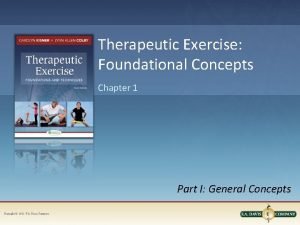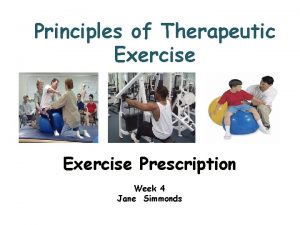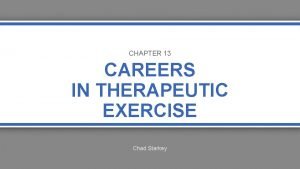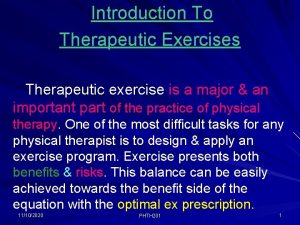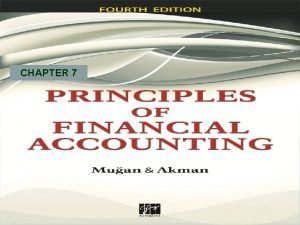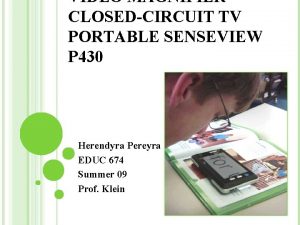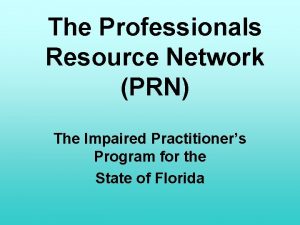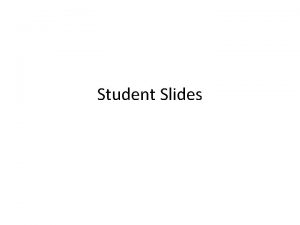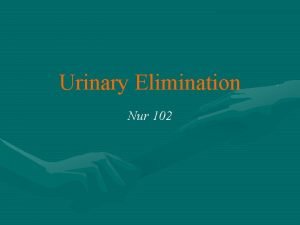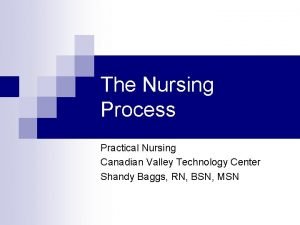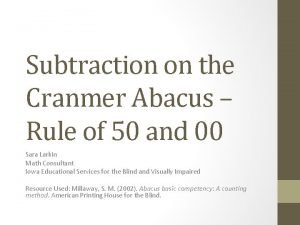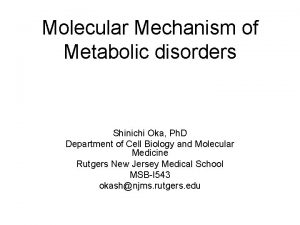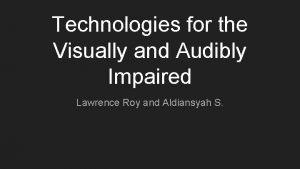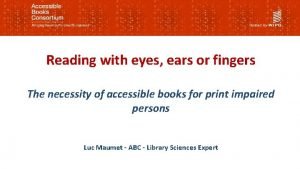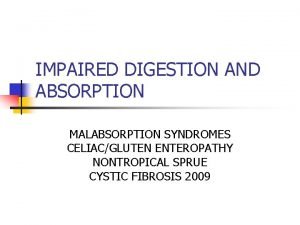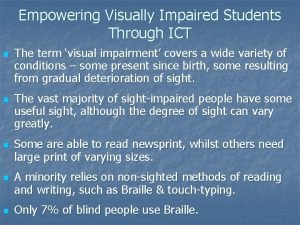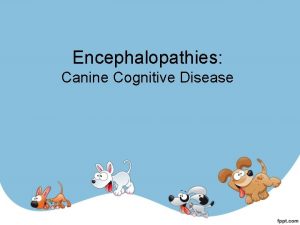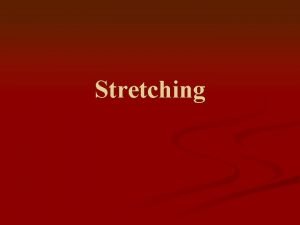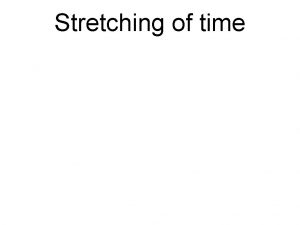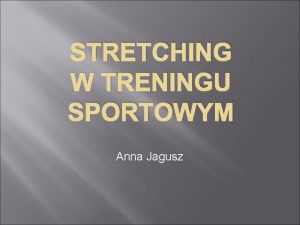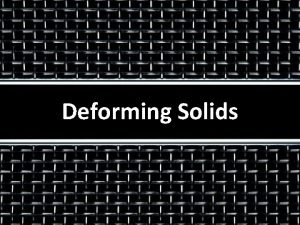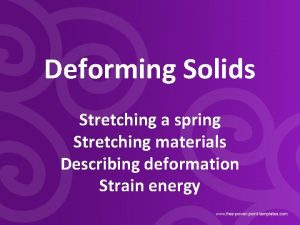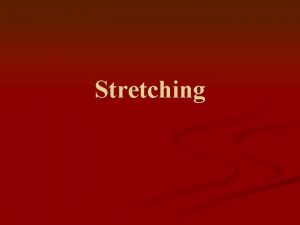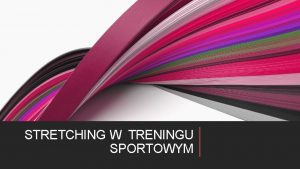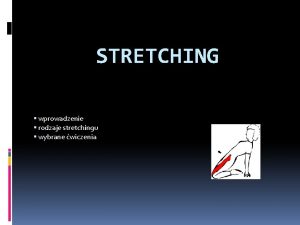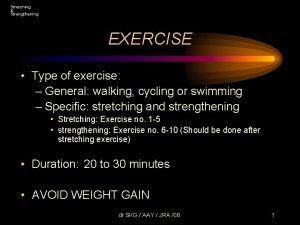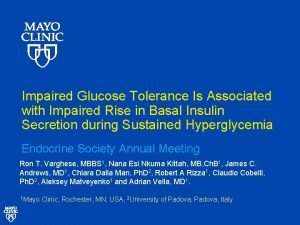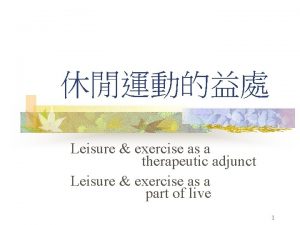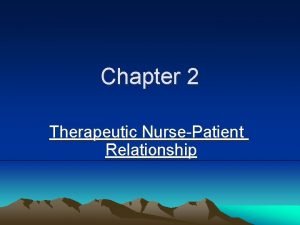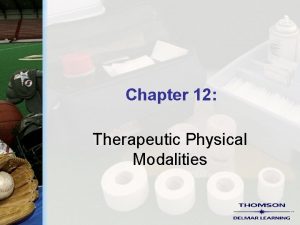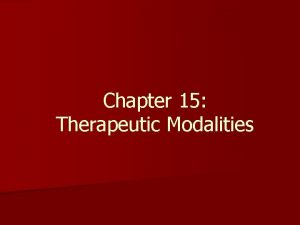Therapeutic Exercise I Chapter 4 Stretching for Impaired




















- Slides: 20

Therapeutic Exercise I Chapter 4 Stretching for Impaired Mobility

Selective Stretching • • Mobility Functional Mobility Flexibility Contractures Overstretching Tightness Selective Stretching ROM needs vary among individuals

Stretching as an integral component to rehab • The supervising PT will determine what structures are restricted and what type of stretches to be implemented • Designed to increase the extensibility of soft tissues • Includes: manual, self, and mechanical stretching • There must be a balance between mobility and stability for MAXIMUM FUNCTION

Hypomobility • Prolonged immobilization • Sedentary lifestyle • Postural malalignment & muscle imbalances • Impaired muscle performance (weakness) associated with musculoskeletal or neuromuscular disorders • Tissue trauma resulting in inflammation & pain • Congenital or acquired deformities

Types of Contractures • • Myostatic Contractures Pseudomyostatic Contractures Arthrogenic and Periarticular Contractures Fibrotic Contracture and Irreversible Contracture

Goals of Stretching • • • Increased flexibility & ROM General Fitness – warm up & cool down Prevention/reduction of soft tissue injuries Decreased post exercise soreness Enhanced performance

Properties of Soft Tissue • Elasticity- the ability of soft tissue to its pre-stretch resting length directly after a short-duration stretch force has been removed • Viscoelasticity- Time dependent property of soft tissue that initially resists deformation, such as change in length, of the tissue when a stretch is first applied. But if the stretch is sustained…it allows a change in the length of the tissue and then enables the tissue to return gradually to its pre-stretched state after the stretch force has been removed • Plasticity- is the tendency of soft tissue to assume a new and greater length after the stretch force has been removed Muscles (contractile and non-contractile) have both elastic and plastic qualities; however, only the connective tissues have viscoelastic qualities

Mechanical Properties of Contractile Tissue • When contractures develop, adhesions in and between collagen fibers resist and restrict movement • If a muscle is immobilized for a prolonged period of time, the outcome is atrophy or weakness…. which can result in an increase in fibrous and fatty tissue in the muscle, and disorganizes collagen • Atrophy can occur in days/weeks and duration plays a major part in the severity of the atrophy

Neurophysiological Properties of Contractile Tissue • Muscle Spindles – changes in length & velocity of length changes • Golgi Tendon Organs – changes in tension; – Autogenic inhibition – Reciprocal inhibition

Mechanical Properties of Non -Contractile Soft Tissue • Non-contractile soft tissue comes in various types of connective tissue: ligaments, tendons, joint capsule, fascia, non-contractile tissue in muscles, and skin (adhesions) • Creep can occur- amount of deformation will depend on the severity of the position and the period of time in the position i. e. : significant thoracic kyphosis

Non-contractile Tissue • Only way to increase extensibility is to remodel its basic structure • Collagen – strength & stiffness; resists tensile deformation • Elastin – provides extensibility • Reticulin – provides tissue bulk • PG’s & GP’s – reduce friction, transports nutrients, maintains space between fibers

Stress Strain Curve • • • Toe Region Elastic Range Elastic Limit Plastic Range Failure

Determinants of Stretching Interventions • • Alignment Stabilization Intensity Duration Speed Frequency Mode

Mode (types) of Stretching • • Manual Self Mechanical PNF

Types of Proprioceptive Neuromuscular Facilitation (PNF) Stretching Techniques • Hold Relax (HR) or Contract Relax (CR) • Agonist Contraction • Hold-Relax with Antagonist Contraction (HR-AC)

Stabilize Proximal versus Distal • When being stretched by the supervising PT/PTA it is common for them to stabilize the proximal attachment and move the distal attachment • When performing a self-stretch often the distal attachment is stabilized as the proximal segment moves • Duration of Stretch-30 second stretch has been identified as the median time frame • Types of stretching: static (static progressive stretching), cyclic (intermittent), ballistic (rapid force)

Adjuncts to Stretching Interventions • Relaxation Training (autogenic training, progressive relaxation, awareness through movement) • Heat (warming of the tissue) – see article • Exercise • Massage (warming of the tissue with a manual technique) • Biofeedback (audio or visual awareness) • Joint traction or oscillation (any joint mobilization techniques to be done by the PT only) • Ice should be used after stretching-preferred in a lengthened

Indications • Limited ROM – adhesions, contractures, scar tissue formation • Structural deformities caused by restricted motion • Muscle weakness & shortening of opposing muscle groups • Total fitness/sports conditioning • Warm up & cool down to decrease soreness

Contraindications • • Bony block Fracture/incomplete union Acute inflammation/infection Sharp acute pain with movement Hematoma Hypermobility Shortened soft tissue necessary for function • Shortened soft tissue providing joint stability

Break for Lab with Lecture on UE Stretching Techniques in Anatomical Planes of Motion (If time permits may review LE’s)
 Therapeutic exercise chapter 1 mcqs
Therapeutic exercise chapter 1 mcqs Principles of therapeutic exercises
Principles of therapeutic exercises Classification of therapeutic exercise
Classification of therapeutic exercise Therapeutic exercise careers
Therapeutic exercise careers Therapeutic exercise definition
Therapeutic exercise definition Impaired receivables
Impaired receivables Closed circuit tv for visually impaired
Closed circuit tv for visually impaired Professionals resource network
Professionals resource network Risk of aspiration nursing diagnosis
Risk of aspiration nursing diagnosis Impaired urinary elimination
Impaired urinary elimination Impaired gas exchange subjective data
Impaired gas exchange subjective data Abacus for visually impaired
Abacus for visually impaired One shade the more one ray the less
One shade the more one ray the less Impaired glucose tolerance
Impaired glucose tolerance Audibly impaired
Audibly impaired Impaired eyes and ears
Impaired eyes and ears Impaired digestion
Impaired digestion Ict for visually impaired students
Ict for visually impaired students Virginia department for the blind and vision impaired
Virginia department for the blind and vision impaired Output devices
Output devices Impaired mentation
Impaired mentation
